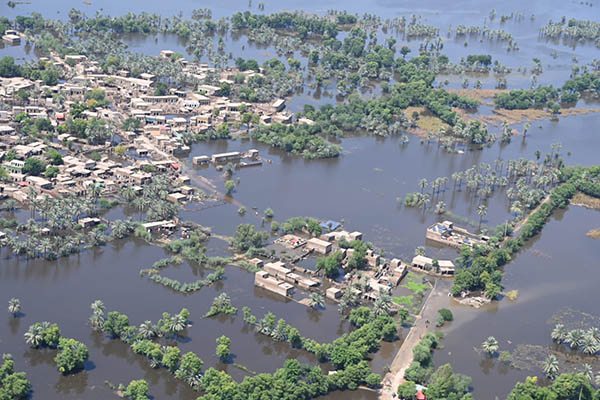
An aerial view of a flood-hit district of Sindh. Twitter
The greatest threat looming over Pakistan—beyond even its economic crunch—is that of climate change-induced disasters, which are expected to worsen in severity and grow in frequency in the years to come. Last year’s floods are the most recent example of this peril, but the country faced similar disasters in 2010, when a flood killed 1,600 people and caused around $10 billion in damages, and in 2015, when a heatwave in Karachi killed over 1,200 people. Addressing an event earlier this week, interim Finance Minister Shamshad Akhtar warned that the country would need an estimated investment of $340 billion by 2030 to tackle the challenges posed by climate change, a tall ask for a country whose economy continues to teeter on the brink of bankruptcy.
Last year’s floods, considered a herald for the natural disasters to come, caused over 1,700 deaths, displaced more than 8 million people, and damaged infrastructure, assets, crops, and livestock, causing economic losses of roughly $30 billion. To offset future disasters, the World Bank has suggested the country needs fundamental shifts in its development path and policies, requiring substantial investments in people-centric climate adaptation and resilience, including an emphasis on renewable energy. Unfortunately, Pakistan’s economic crunch makes this difficult to achieve, with widespread poverty and unrestrained population growth compounding the crisis. The state’s hope of attracting global funding to build its resilience, particularly in sectors such as water management, agriculture, urban infrastructure, municipal services, and housing, also seems a tall ask, especially as the country continues to wait for delivery of aid pledges for flood affectees last year.
The greatest tragedy is that Pakistan emits less than 1 percent of global greenhouse gas emissions, but is among the top 10 countries most at risk from climate change. With the country’s ratio of urban residents estimated to exceed 50 percent by 2050, the state’s focus must shift to reducing pollution in cities, making them more livable. This requires urgent reforms for integrated land-use, increased investments in municipal services, energy efficiency and better transportation. To this end, authorities must strengthen local governments, which would be best placed to determine the actions required to facilitate the public, especially the most vulnerable segments of society. Failing this, Pakistanis would continue to fall victim to climate change-induced disasters, which an increasingly polarized world is in no position to bail it out from.
